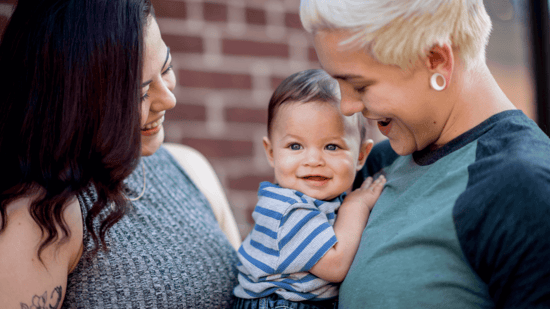What is Reciprocal IVF? How It Works, Treatment Costs & More
June 27th, 2023 | 9 min. read

Reciprocal IVF is an amazing family-building option for same-sex female (or cis female/trans male) couples who both want to play a biological role in the development of their baby. Here's everything you should know about the process, straight from an LGBTQ+ fertility specialist.
In this article:
- What is reciprocal IVF?
- Reciprocal IVF Step-by-Step
- How long does reciprocal IVF take?
- Considerations for Reciprocal IVF
- Who is a good candidate for reciprocal IVF?
- FAQs About Reciprocal IVF
- How much does reciprocal IVF cost?
- Does insurance cover reciprocal IVF?
- Are success rates different for RIVF and traditional IVF?
What is reciprocal IVF?
Reciprocal IVF (RIVF) is a fertility treatment pathway for same-sex female couples (or a cis woman and trans man) who wish to share in the biological process of having a baby together.
In an RIVF cycle (also sometimes referred to as partner-assisted IVF or co-IVF), oocytes (eggs) from one partner are retrieved and fertilized with donor sperm to create embryos. These embryos can subsequently be transferred into the uterus of the other partner.
This allows both partners to personally participate in the same pregnancy, since one partner supplies the eggs to create the embryos, and the other partner carries the resulting pregnancy.
Reciprocal IVF Step-by-Step
Reciprocal IVF is similar to traditional IVF treatment, with the exception of both partners being able to be intimately involved in the process. Some couples like the idea of both being biologically connected to the child, since one is genetically linked by contributing eggs, and the other is bonded by carrying the pregnancy to term and delivering the baby.
Pretty incredible, right? Let's break down the process to see how it all works.
Step 1: Ovarian Stimulation (Partner A)
With reciprocal IVF, the pregnancy is biologically related to Partner A, but carried by Partner B. Partner A will go through the standard IVF process to create embryos, taking injectable fertility medications to stimulate the ovaries and mature multiple eggs at the same time.
Step 2: Egg Retrieval (Partner A)
During an egg retrieval (which is a minor surgical procedure), those resulting eggs will be carefully removed from Partner A's ovaries, then fertilized with the couple's chosen donor sperm in the IVF laboratory in order to create embryos.
Step 3: Embryo Development
The resulting embryos will be cultured and closely monitored by specially-trained embryologists in the lab until they reach the stage at which they can be transferred and/or frozen.
If the couple elects to have preimplantation genetic testing (PGT) of their embryos, the testing will be performed after the embryos reach around Day 5 of development. Once PGT results are received, and the couple discusses any concerns or questions with their reproductive endocrinologist (fertility specialist), an embryo transfer will be scheduled.
Step 4: Embryo Transfer (Partner B)
During an embryo transfer, the embryo (created from Partner A's egg and donor sperm) will then be transferred into the uterus of Partner B. Most of the time, the embryos are frozen and a single thawed embryo is transferred to the uterus of Partner B in a separate cycle.
However, it is also possible for Partner B (the embryo recipient) to take fertility medication to prepare their uterus for embryo implantation and have a "fresh" embryo transfer around five days after Partner A's egg retrieval.
Note: If Partner B (who will be carrying the pregnancy) prefers to coordinate the embryo transfer with their body's natural menstrual cycle, this will require less fertility medication.
Step 5: Pregnancy Test Results
Around nine days after the embryo transfer, the carrying partner will return to their fertility clinic for blood work. The results of that blood work will indicate whether or not the transfer was successful (if they are pregnant or not).
How long does reciprocal IVF take?
All in all, a single reciprocal IVF cycle can take anywhere from 2-6 months, depending on the following factors and other potential variables:
- Fertility testing: Portions of the pre-IVF diagnostic work-up are timed to the menstrual cycle, so completing this necessary pre-cycle testing can take a month or two.
- Choosing a donor: It also takes time to complete other parts of the process, like selection of donor sperm and getting insurance authorization for the treatment cycle.
- IVF cycle: The actual IVF cycle takes about two weeks, and consists of hormonal injections for ovarian stimulation, followed by an egg retrieval. It takes another 5-7 days to culture the embryos in the laboratory until they can be transferred or frozen.
- Other variables: When embryos are frozen and the transfer to the carrying partner occurs in a separate IVF cycle, this process takes an additional month. If preimplantation genetic testing (PGT) of embryos is desired, this can take 1-2 weeks. Additionally, if there are any issues that need addressing prior to undergoing RIVF (such as polyps that need to be removed surgically), this will add to the length of the process.
Remember: You may need more than one RIVF cycle to achieve pregnancy, so if you need to repeat the process more than once, this will of course add to your timeline as well.
Alternative Family-Building Pathways
There are many hopeful parents who pursue reciprocal IVF, but others may choose intrauterine insemination (IUI) with donor sperm, INVOcell, or traditional IVF (where the same partner both provides the eggs and carries the pregnancy) depending on their individual circumstances.
Considerations for Reciprocal IVF
While reciprocal IVF is an incredible family-building option for many couples, there are some important things to understand before moving ahead with this treatment pathway.
Who is a good candidate for reciprocal IVF?
Ideal candidates for RIVF are same-sex female couples (or cis female/trans male couples) who:
- Both want to be involved in the creation of a pregnancy
- Are comfortable going through the fertility treatment process
- Are otherwise good medical candidates for IVF and/or pregnancy
Family Size & Biologically-Related Siblings
For couples who want to have multiple children, some plan to use sibling embryos from the same egg and sperm, with one partner carrying all pregnancies. Others plan to undergo separate cycles of IVF, often with the same sperm donor, and to each have a transfer of an embryo from their partner’s eggs, so that both partners are connected to all pregnancies.
Choosing a Sperm Donor
Some couples may choose a donor who shares physical characteristics or ethnic background as one or both partners. Other considerations include:
- Deciding whether to use a known or de-identified (anonymous) sperm donor
- If using a known donor, they will undergo semen analysis and infectious disease testing
- Speaking with an attorney regarding legal rights (if using donor sperm, this is typically handled by the sperm bank)
Genetic Compatibility with Sperm Donor
Consider your full family-building plan (for all future children) at the start of the process.
For example, if one partner is planning to go through IVF and create embryos first, but the other partner may do so in the future for a second child, you may want to purchase additional vials of donor sperm upfront in order to ensure that you can use the same donor for all pregnancies.
Additionally, a couple may want to consider genetic carrier screening prior to choosing a sperm donor in order to make sure both partners are genetically compatible with the same donor.
FAQs About Reciprocal IVF
There is a lot to consider when exploring reciprocal IVF, and it's natural to want to learn all you can about the process before making your final decision. Here are some of the most common questions we hear about RIVF at our partner fertility clinic:
How much does reciprocal IVF cost?
Due to various factors (such as your insurance coverage and choice of fertility clinic), the cost of reciprocal IVF varies widely, and can be anywhere from $10,000 to $25,000 or more. Traditional IVF and reciprocal IVF typically cost about the same, with the exception of donor sperm.
Does insurance cover reciprocal IVF?
Unfortunately, reciprocal IVF is typically not covered by insurance (particularly when a couple has no known fertility issues) and many employers still don't offer fertility coverage. In many cases, qualifying for medically-assisted fertility treatment coverage requires a clinical diagnosis of "infertility" (typically defined as trying to conceive without success for 6-12 months).
This outdated definition excludes millions of LGBTQ+ couples who need the assistance of a third party (an egg or sperm donor or a gestational surrogate, for example) to grow their family.
Note: As of June 2023, 21 states have passed fertility insurance coverage laws and 14 of those state mandates include IVF coverage. That being said, the archaic definition of infertility above still typically applies - even when a state technically mandates coverage.
How do you choose who will provide eggs and who will carry the pregnancy?
This is a personal decision that varies from couple to couple. Some couples start the process with a pre-determined plan about who will undergo IVF (and "donate" their eggs), and who plans to carry the pregnancy.
Others may make the decision based on the results of their medical work-up. For example, one partner may have a higher chance of success of creating healthy embryos than another based on age, ovarian reserve (egg quantity) or other factors.
Do both partners need to undergo fertility testing?
Yes! Both partners will need to have a pelvic ultrasound and blood work, which is standard for all patients undergoing IVF and/or planning to become pregnant.
Genetic carrier screening is done only by the person providing eggs, since they will be the one who is biologically related to the pregnancy. (If both partners wish to carry a pregnancy, both should undergo screening.)
The partner who carries the pregnancy will also do a saline ultrasound (SIS) to further evaluate their uterus prior to pregnancy. During this test, sterile saline (salt water) is infused into the uterus, which helps to better visualize the inside cavity where an embryo will implant and grow.
Note: If any abnormalities such as fibroids, polyps or scar tissue are discovered during your saline ultrasound, your doctor will discuss potential solutions with you, which may include minor surgical procedures performed prior to undergoing RIVF.
Are success rates different for RIVF and traditional IVF?
The success rates for RIVF are about the same as for traditional IVF, and primarily depend on the age and ovarian reserve (egg quantity) of the person who is undergoing IVF. Couples with no fertility issues typically have an excellent chance of success with RIVF.
Explore Your Family-Building Options
If you're considering reciprocal IVF or other biological family-building pathways, we're here to help answer any additional questions you may have! Reach out to us to discuss your options with an LGBTQ+ fertility expert, or browse through our other resources to learn more.
Dr. Laura Meyer is a reproductive endocrinologist at Illume Fertility who is board certified in both reproductive endocrinology and obstetrics and gynecology. After graduating from the NYU School of Medicine, she completed both her residency and fellowship at New York Presbyterian Hospital - Weill Cornell Medical Center. Dr. Meyer is a fellow of the American College of Obstetrics and Gynecology and a member of the American Society for Reproductive Medicine and the Society for Reproductive Endocrinology and Infertility. Dr. Meyer works closely with many LGBTQ+ parents-to-be on their journey to parenthood.



